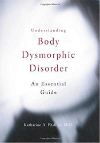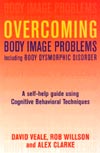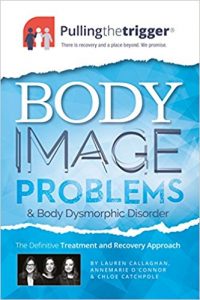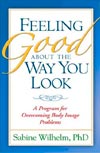Self-help books for BDD
Self-help books may assist people with BDD who are not yet ready to engage in therapy, or may be an additional resource during CBT or for family members who are struggling to cope. Some have more of an emphasis on education and understanding, others on practical treatment guidance.

Understanding Body Dysmorphic Disorder: An Essential Guide
Katharine Phillips Oxford University Press
In a world obsessed with appearance, it is not surprising that body dysmorphic disorder, or BDD — an emotionally painful obsession with perceived flaws in one’s appearance — has manifested itself as a troubling and relatively common problem for many individuals. In The Broken Mirror, the first and most definitive book on BDD, Dr. Katharine A. Phillips provided a comprehensive manual for patients and their physicians by drawing on years of clinical practice, scientific research, and professional evaluations of over 1,000 patients. Now, in Understanding Body Dysmorphic Disorder: An Essential Guide , the world’s leading authority on BDD reaches out to patients, their friends, and their families with this concise and updated handbook.

The Broken Mirror: Understanding and Treating Body Dysmorphic Disorder
Katharine Phillips Oxford University Press
Katharine Phillips is the leading researcher in BDD in the world. This is a revised and updated version of the original 1996 edition. The author draws on more recent research in this field and on her extensive clinical experience to give a comprehensive picture of current understanding of BDD, and practical identification and treatment guidance. There are detailed and capturing case descriptions interspersed with research findings and data throughout the book, which provides an interesting and informative read. Patients’ stories are thoughtfully used to demonstrate a variety of presentations, ranging from mild cases that cause some interference and distress, to severe cases that are overwhelming and devastating. Theories on how BDD develops are discussed in detail and include genetic and neurobiological vulnerabilities as well as psychological and sociocultural influences. Screening questionnaires are included, of use to both patients and professionals, offering a clear and practical way of quantifying and diagnosing possible BDD. However, only 4 out of the 18 chapters are given to treatment: an overview of effective treatments, a particularly thorough, specific and somewhat dry chapter on medication, one chapter on CBT for BDD, and then treatments that do not work such as cosmetic and surgical procedures.

Overcoming Body Image Problems including Body Dysmorphic Disorder
David Veale, Rob Willson and Alex Clarke Robinson (2009)
As implied by the title, this book provides a step-by-step, self-help guide to understanding and treating body image problems using cognitive-behavioural techniques. It follows a current evidence-based treatment manual directed to the patient, based on how a clinician should provide CBT for a person with body image concerns. Post-introductions, there is a single chapter with screening questions given to identifying the presence of a body image problem. The remaining thirteen chapters are a concise combination of information and actions directed to a person with BDD and designed to develop their own understanding, formulation and treatment of BDD. It is punctuated throughout with practical exercises, worksheets, common examples, and skills training techniques. The reader is guided, via an easy-to-read manual, through how to apply the cognitive-behavioural techniques. There is also a chapter on medication for BDD. The tone of the book from the outset is positive, proactive and hopeful. Declaration of Interest: David Veale and Rob Willson are trustees of the BDD Foundation.

Appearance Anxiety: A Guide to Understanding Body Dysmorphic Disorder for Young People, Families and Professionals
Maudsley Hospital National and Specialist OCD, BDD and Related Disorders Service
The first book for teens that explains the causes and impact of body dysmorphic disorder (BDD). The book is interspersed with accounts and artwork from young people with BDD, along with perspectives of their families. BDD is a debilitating mental health disorder, and this book gives advice on treatment including CBT and medication, and shows where to get help.
It increases awareness, provides solidarity for people with BDD, and alerts others to key signs and symptoms so they can prevent further suffering. It also includes a short section for families and professionals on what they can do to help, making this the go-to book for professionals and families to recommend to teens, as well an invaluable resource for young people themselves.

The Parents’ Guide to Body Dysmorphic Disorder: How to Support Your Child, Teen or Young Adult
Nicole Schnackenberg, Amita Jassi, Benedetta Monzani
The first book offering support for parents and carers of children and young people with Body Dysmorphic Disorder (BDD), this guidebook explains the condition as well as the impact that it may have in education settings, family life and socialisation.
The guide begins by explaining how and why BDD emerges, before moving onto an exploration of how the mental health condition presents itself emotionally, psychologically, physically and behaviourally. It then offers practical advice and guidance for parents and carers on talking to their child about BDD, seeking professional treatment, considering medication, managing social media use, working with schools to build a recovery team and more.
The Parent’s Guide to Body Dysmorphic Disorder is an essential guidebook for parents of children of children and young people with BDD.

Body Image Problems & Body Dysmorphic Disorder: The Definitive Treatment and Recovery Approach (Pulling the Trigger)
Chloe Catchpole, Lauren Callaghan, and Dr Annemarie O’Connor (2017)
Written by a woman, Chloe Catchpole, who has suffered from debilitating body image issues and two leading clinical psychologists, Lauren Callaghan and Dr Annemarie O’Connor, it provides simple yet highly effective self-help methods to help overcome body image concerns and Body Dysmorphic Disorder (BDD).

Overcoming Body Dysmorphic Disorder: A Cognitive Behavioral Approach to Reclaiming Your Life
Fugen Neziroglu New Harbringer
Written by American BDD expert Fugen Neziroglu, Overcoming Body Dysmorphic Disorder offers BDD individuals a practical guide to the mindfulness, acceptance, and exposure and response prevention strategies that can help them overcome the disorder. This comprehensive guide offers self-assessment tools and a complete cognitive behavioural therapy (CBT) program for reducing the effect of BDD on sufferers’ lives. Its step-by-step guidance and easy-to-follow exercises are sure to help readers with BDD move beyond their anxieties and start living with greater freedom and confidence.

Feeling Good About the Way You Look: A Program for Overcoming Body Image Problems
Sabine Wilhelm New Harbringer (2006)
The emphasis of this book is on self-assessment and explanation of appearance concerns, their possible development, and understanding what maintains them. Basic CBT principles are described and examples are given for challenging the existing thinking, beliefs and associated behaviours, making this book a good choice for those with milder body image concerns who are motivated to alleviate their preoccupation and distress. The content is from an American perspective.

The BDD Workbook
James Claiborn & Cherry Pedrick
This book introduces itself as resource for clinicians treating BDD as well as a self-directed intervention for those with less severe body image problems. It promotes recovery by emphasizing the importance of balance in our perceptions and responses to body image. It is divided into two halves; the first is psychoeducational and succinctly builds an understanding of BDD in its cultural, media and peer context; the second is a step-by-step series of concise explanations complemented by clinical examples and practical guidance on how to change your body image, thinking and associated behaviours and habits to be more balanced. Unlike some of the other books discussed here, readiness for and the process of change are addressed thoughtfully and thoroughly, and individual chapters are given to self-esteem and social isolation. This is a neat and straightforward workbook for individuals with body image concerns and BDD. The approach is from an American perspective of BDD.

The Body Image Workbook
Tom Cash New Harbringer
This book accessibly navigates the reader towards changing their relationship with their body through eight clearly defined steps. It is a structured combination of theory, research and clinical examples and from the outset is hopeful, considered and empathetic. Cash competently imparts knowledge and skills to the individual, with the intention of promoting autonomy and empowerment in a sensitive manner. He encourages action and progress through the tone of the book as well as practical goal and summary sheets at the end of each step. The book is not specific to BDD but for body image problems in general. It is skillfully written and a useful tool, with over 40 help sheets suitable for use by an individual or for a clinician as an adjunct to therapy.

The Adonis Complex: How to Identify, Treat and Prevent Body Obsession in Men and Boys: The Secret Crisis of Male Body Obsession
Harrison G. Pope, Katharine Phillips, and Roberto Olivardia Touchstone
Drawing from their clinical work and using detailed case descriptions and numerous results from studies, the authors address male body image concerns. These include ‘muscle dysmorphia’, men concerned that they are not muscular enough; eating disorders, men concerned that they are not thin enough; and BDD. The book introduces two body image symptom tests: a brief questionnaire quantifying timepreoccupied with body image, distress and associated behaviours, and a test in which the reader can adjust the body fat and muscularity of a body outline to help the clinician as well as himself to understand how he perceives his body and how he believes others see him. The emphasis of this book is on the identification, and the how-and-why, of male body image problems, including modern society and media influence, and gives only a brief overview of available treatments. The authors indicate that there are an increasing number of men attempting to achieve physical perfection. They highlight the shame and secrecy that exists within concerns with body image with the aim of exposing the hidden prevalence of body image problems.
Donate today to support our work
Together, we can relieve suffering for people with BDD, while advancing research, treatments and awareness of the condition.
